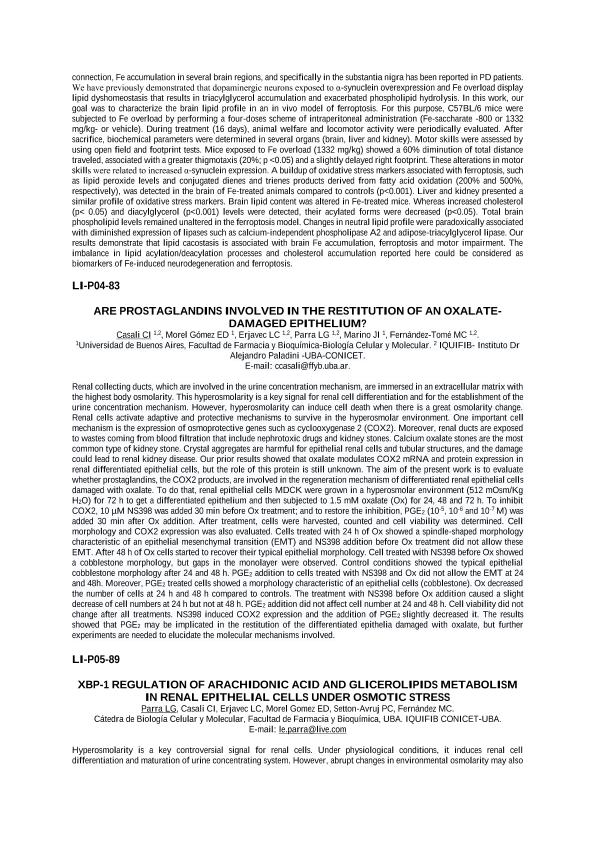Evento
Are prostaglandins involved in the restitution of an oxalatedamaged epithelium?
Casali, Cecilia Irene ; Morel Gómez, Emanuel Dario
; Morel Gómez, Emanuel Dario ; Erjavec, Luciana Cecilia
; Erjavec, Luciana Cecilia ; Parra, Leandro Gastón
; Parra, Leandro Gastón ; Marino, José Ignacio; Fernández Tomé, M. C.
; Marino, José Ignacio; Fernández Tomé, M. C.
 ; Morel Gómez, Emanuel Dario
; Morel Gómez, Emanuel Dario ; Erjavec, Luciana Cecilia
; Erjavec, Luciana Cecilia ; Parra, Leandro Gastón
; Parra, Leandro Gastón ; Marino, José Ignacio; Fernández Tomé, M. C.
; Marino, José Ignacio; Fernández Tomé, M. C.
Tipo del evento:
Reunión
Nombre del evento:
LVII SAIB Meeting; XVI SAMIGE Meeting
Fecha del evento:
11/2021
Institución Organizadora:
Sociedad Argentina de Investigación en Bioquímica y Biología Molecular;
Título de la revista:
Biocell
Editorial:
Tech Science Press
ISSN:
1667-5746
Idioma:
Inglés
Clasificación temática:
Resumen
Renal collecting ducts, which are involved in the urine concentration mechanism, are immersed in an extracellular matrix withthe highest body osmolarity. This hyperosmolarity is a key signal for renal cell differentiation and for the establishment of theurine concentration mechanism. However, hyperosmolarity can induce cell death when there is a great osmolarity change.Renal cells activate adaptive and protective mechanisms to survive in the hyperosmolar environment. One important cellmechanism is the expression of osmoprotective genes such as cyclooxygenase 2 (COX2). Moreover, renal ducts are exposedto wastes coming from blood filtration that include nephrotoxic drugs and kidney stones. Calcium oxalate stones are the mostcommon type of kidney stone. Crystal aggregates are harmful for epithelial renal cells and tubular structures, and the damagecould lead to renal kidney disease. Our prior results showed that oxalate modulates COX2 mRNA and protein expression inrenal differentiated epithelial cells, but the role of this protein is still unknown. The aim of the present work is to evaluatewhether prostaglandins, the COX2 products, are involved in the regeneration mechanism of differentiated renal epithelial cellsdamaged with oxalate. To do that, renal epithelial cells MDCK were grown in a hyperosmolar environment (512 mOsm/KgH2O) for 72 h to get a differentiated epithelium and then subjected to 1.5 mM oxalate (Ox) for 24, 48 and 72 h. To inhibitCOX2, 10 µM NS398 was added 30 min before Ox treatment; and to restore the inhibition, PGE2 (10-5, 10-6and 10-7 M) wasadded 30 min after Ox addition. After treatment, cells were harvested, counted and cell viability was determined. Cellmorphology and COX2 expression was also evaluated. Cells treated with 24 h of Ox showed a spindle-shaped morphologycharacteristic of an epithelial mesenchymal transition (EMT) and NS398 addition before Ox treatment did not allow theseEMT. After 48 h of Ox cells started to recover their typical epithelial morphology. Cell treated with NS398 before Ox showeda cobblestone morphology, but gaps in the monolayer were observed. Control conditions showed the typical epithelialcobblestone morphology after 24 and 48 h. PGE2 addition to cells treated with NS398 and Ox did not allow the EMT at 24and 48h. Moreover, PGE2 treated cells showed a morphology characteristic of an epithelial cells (cobblestone). Ox decreasedthe number of cells at 24 h and 48 h compared to controls. The treatment with NS398 before Ox addition caused a slightdecrease of cell numbers at 24 h but not at 48 h. PGE2 addition did not affect cell number at 24 and 48 h. Cell viability did notchange after all treatments. NS398 induced COX2 expression and the addition of PGE2 slightly decreased it. The resultsshowed that PGE2 may be implicated in the restitution of the differentiated epithelia damaged with oxalate, but furtherexperiments are needed to elucidate the molecular mechanisms involved.
Palabras clave:
COX2
,
PROSTAGLANDINS
,
OXALATE
Archivos asociados
Licencia
Identificadores
Colecciones
Eventos(IQUIFIB)
Eventos de INST.DE QUIMICA Y FISICO-QUIMICA BIOLOGICAS "PROF. ALEJANDRO C. PALADINI"
Eventos de INST.DE QUIMICA Y FISICO-QUIMICA BIOLOGICAS "PROF. ALEJANDRO C. PALADINI"
Citación
Are prostaglandins involved in the restitution of an oxalatedamaged epithelium?; LVII SAIB Meeting; XVI SAMIGE Meeting; Argentina; 2021; 1-1
Compartir



